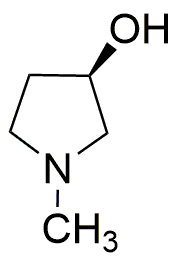(R)-(-)-1-Methyl-3-pyrrolidinol is widely utilized in research focused on:
- Pharmaceutical Development: This compound serves as an important intermediate in the synthesis of various pharmaceuticals, particularly in the development of drugs targeting neurological disorders.
- Chiral Catalysis: Its chiral nature makes it a valuable reagent in asymmetric synthesis, allowing researchers to create enantiomerically pure compounds, which are crucial in drug formulation.
- Cosmetic Formulations: The compound is used in the cosmetic industry for its potential skin-conditioning properties, enhancing the texture and feel of personal care products.
- Flavor and Fragrance Industry: It is employed as a flavoring agent due to its unique aroma profile, contributing to the formulation of various food and beverage products.
- Research in Neurochemistry: This compound is studied for its effects on neurotransmitter systems, providing insights into potential therapeutic applications for cognitive enhancement and mood regulation.
General Information
Properties
Safety and Regulations
Applications
(R)-(-)-1-Methyl-3-pyrrolidinol is widely utilized in research focused on:
- Pharmaceutical Development: This compound serves as an important intermediate in the synthesis of various pharmaceuticals, particularly in the development of drugs targeting neurological disorders.
- Chiral Catalysis: Its chiral nature makes it a valuable reagent in asymmetric synthesis, allowing researchers to create enantiomerically pure compounds, which are crucial in drug formulation.
- Cosmetic Formulations: The compound is used in the cosmetic industry for its potential skin-conditioning properties, enhancing the texture and feel of personal care products.
- Flavor and Fragrance Industry: It is employed as a flavoring agent due to its unique aroma profile, contributing to the formulation of various food and beverage products.
- Research in Neurochemistry: This compound is studied for its effects on neurotransmitter systems, providing insights into potential therapeutic applications for cognitive enhancement and mood regulation.
Documents
Safety Data Sheets (SDS)
The SDS provides comprehensive safety information on handling, storage, and disposal of the product.
Product Specification (PS)
The PS provides a comprehensive breakdown of the product’s properties, including chemical composition, physical state, purity, and storage requirements. It also details acceptable quality ranges and the product's intended applications.
Certificates of Analysis (COA)
Search for Certificates of Analysis (COA) by entering the products Lot Number. Lot and Batch Numbers can be found on a product’s label following the words ‘Lot’ or ‘Batch’.
*Catalog Number
*Lot Number
Certificates Of Origin (COO)
This COO confirms the country where the product was manufactured, and also details the materials and components used in it and whether it is derived from natural, synthetic, or other specific sources. This certificate may be required for customs, trade, and regulatory compliance.
*Catalog Number
*Lot Number
Safety Data Sheets (SDS)
The SDS provides comprehensive safety information on handling, storage, and disposal of the product.
DownloadProduct Specification (PS)
The PS provides a comprehensive breakdown of the product’s properties, including chemical composition, physical state, purity, and storage requirements. It also details acceptable quality ranges and the product's intended applications.
DownloadCertificates of Analysis (COA)
Search for Certificates of Analysis (COA) by entering the products Lot Number. Lot and Batch Numbers can be found on a product’s label following the words ‘Lot’ or ‘Batch’.
*Catalog Number
*Lot Number
Certificates Of Origin (COO)
This COO confirms the country where the product was manufactured, and also details the materials and components used in it and whether it is derived from natural, synthetic, or other specific sources. This certificate may be required for customs, trade, and regulatory compliance.


